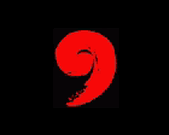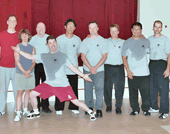

Becoming Smooth – Luo Dexiu 2004
by Peter Nason
Luo Laoshi breezed into town this year for his much anticipated annual seminar. As usual the days and nights were filled with arduous training, good cheer and endless insights into the Yizong system of Bagua Zhang and orthodox Hebei Xingyi.
Imparting concepts from his extensive research, theory and readily expressed enthusiasm, Luo left the attendees with a broad look into the depth and breadth of the Yizong methods.
While body method may be king and technique the queen, movement is the ace in this deck of cards. The Human body's natural dynamic is best expressed in movement and what system of movement depends on the body's natural dynamics, rhythm and systems more heavily than Bagua Zhang?
At the seminars Luo Dexiu would exhort us to relax but stay vigilant. There was emphasis on theYi, but you do not fight purely with your mind. While Yi is penultimate to the practice, a relaxed and improvisational sense of body and individual usage is required. “The power is in the motion, not the emotion” Luo said. The body naturally has the power; don't restrict it with a critical mind. Feeling within the body is just as, if not more important, than any conscious or unconscious thought system while practicing.
During the first course of the seminar Luo Laoshi taught Xingyi's five element training and discussed San-Ti and the principles of the Xingyi body method. While the basic requirements of Xingyi demand that one strictly adhere to proper alignment and observation of the nine powers, they should also be both natural and lively. While one's San-ti may look externally rigid on the outside, it may be proper for the individual person's body type. Principles are principles. What is important is what is going on inside not the outward “appearance” of the body or the “frame”. Nowhere in the annals of Xingyi does it say that the stylized poses of the Masters are to imitated, what is stressed is finding those precious alignments and powers within yourself. They say a picture is worth a thousand words, but I'm not certain that it applies to the internal arts of China .
Looking through the galleries of “Masters” that we are left with today, whose San Ti is “correct”? Whose is true? Whose is the real expression?
According to Luo Dexiu? Find your own. “Bear shoulders, tiger head, eagle hands, dragon body… use your imagination” Luo exhorts. Explore the powers and alignments and use them. Express the power in all directions, but stay relaxed and smooth. The mind should never be rigid and fixed, especially when holding San Ti. After flurries of Pi-Chuan and Heng-Chuan, Luo would have us remain in San Ti for a moment. “San Ti is where you relax and gather yourself. Let everything, especially the organs and body “sink” and then like an arrow shot from a bow move forth again.
Luo's applications of the five element fists were both first rate and eye opening.
With a keen eye he meticulously corrected the participant's two man applications and emphasized the smooth, irresistible power of Xingyi. The use of the body's “natural” power was stressed. “Become smooth” Luo would exhort and this was to be the recurrent theme of his five day stay here in Boston .
The second night of the seminar, we focused on Siping Tou Shou, the push hands variants as practiced in the Yizong system of Bagua Zhang. The variants and methods were all meticulously explained and employed. Luo Laoshi emphasized the “ting” jin and listening skills. This was also explained as “eating” jin, but alas, that is another vague concept that I could never quite put together.
I asked Laoshi if we should actively be trying to “bait” our opponent and the said “No, it is a cooperative exercise, if you find the hole good, show him, Otherwise it's best to work on moving and turning your structure.” He explained about having a bit hidden, use enough to get the job done, but save something. Your opponent may come on strong and show you his “power”, but you need not respond by throwing all your cards on the table. I found this to be sound advice. Personally? I'm not as sensitive as most of the people I push with, but I feel that Luo gave me an interesting take on “push hands” in that I may not be better than my opponent, I can hold my own by listening and following.
The third day of the seminar was a marathon session on line two of the Hou Tien (Post Heaven Linear Palms) of the Yizong Bagua Zhang method. This line is known as “Kan Gua” and it contains the methods for hitting in the houtians. As described on Luo Laoshi's website, the key focus is that “You must practice diligently until they are very familiar. Your hands must be quick and your eyes rapid, then when your arm extends its form will not be seen, and when you hit its shadow will not be seen.”
For those unfamiliar with the “Hou Tien” or post heaven lines, the Hou Tien contain the linear methods of the Yizong Bagua Zhang system as handed down by Gao I-Sheng. The Hou Tien contain the bulk of the Yizong Men strategy and fighting techniques. While all the lines may be performed on the circle, the Hou Tien, much like the eight big “Pre-Heaven” palms of the Yizong system, are taught in a static and linear fashion initially.
Luo Laoshi guided us through each movement of the line in painstaking detail. He would then have his senior student George Wood (Chief instructor, Zong Wu Men) take us through the lines with more tempo, while he corrected our individual tendencies and flaws. Luo would exhort us to find the “tempo” within our bodies. Nothing ever stops because everything moves at once. He wanted us to move like “dancers” and to flow from movement to movement. This becoming “smooth” had resurfaced yet again.
While I had originally thought of tempo as drum beats and timing, I now view it as more of guitar strings, one note may still be floating in the air when the next is struck, overlapping and varying to compose the moment.
In application we were taught to be swift, sure and in control through proper control and “ting” jin as emphasized on the second night of the seminar. Luo expounded on many “What if he does this? What if he's too big? What if he's to strong?” and showed us endless variations in application.
During a break, Luo showed me how single palm change does indeed contain all of Bagua and that everything is just a variation once you understand the change and how it is applied to the various permutations of Bagua movement.
While one can often be overwhelmed at the enormity of the Yizong System, there is not one who can say that any of it is “useless” or does not directly tie in to a functional Bagua Zhang skill. The system may be comprehensive and large, but everything from the simplest movement of the Jiben Shoufa to the complex undulations of the Wu Long Bai Wei, re-enforces and builds the skills necessary to understanding the system as a whole.
As ever, the greatest “thrill” (for lack of a better word) of working with Luo Dexiu is the “hands on” aspect. While both fascinating and unsettling at the same time, Luo Laoshi is clearly able to demonstrate the internal power and improvisational techniques of his BaGua with fine control. The variations within situations were endless; the level of mental and physical alacrity he exhibited left no doubt as to why Bagua is known as the “art of change.”
Upon contact he is able to manipulate one's structure and totally control one's body. This is the hallmark of the Yizong school as recorded by Robert Smith in the classic treatise “Chinese Boxing: Masters and methods.” As if the psychological effects of being totally off balanced and thoroughly physically controlled was not enough, Luo Laoshi's ability to improvise and change tactics at the speed of touch are just as astounding. The smoothness and subtlety of his power and speed are simply astonishing and overwhelming. It is akin to “playing” hands with a six foot swiss army knife powered by a pair of truck batteries. Futile, yet exhilirating.
Through all the sweat, bruises and exhaustion I believe myself and my colleagues got a good look at what proper Bagua should, and can be. The work is hard and the task is daunting, but the fighting skills and health aspects of Yizong internal arts are more than worth working for. With fond recollections and many pages of notes to peruse, many of us will be counting the months in anticipation of Luo Laoshi's return.
